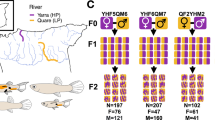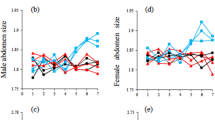Abstract
The maintenance of genetic variation in traits under natural selection is a long-standing paradox in evolutionary biology1,2,3. Of the processes capable of maintaining variation, negative frequency-dependent selection (where rare types are favoured by selection) is the most powerful, at least in theory1; however, few experimental studies have confirmed that this process operates in nature. One of the most extreme, unexplained genetic polymorphisms is seen in the colour patterns of male guppies (Poecilia reticulata)4,5. Here we manipulated the frequencies of males with different colour patterns in three natural populations to estimate survival rates, and found that rare phenotypes had a highly significant survival advantage compared to common phenotypes. Evidence from humans6,7 and other species8,9 implicates frequency-dependent survival in the maintenance of molecular, morphological and health-related polymorphisms. As a controlled manipulation in nature, this study provides unequivocal support for frequency-dependent survival—an evolutionary process capable of maintaining extreme polymorphism.
This is a preview of subscription content, access via your institution
Access options
Subscribe to this journal
Receive 51 print issues and online access
$199.00 per year
only $3.90 per issue
Buy this article
- Purchase on Springer Link
- Instant access to full article PDF
Prices may be subject to local taxes which are calculated during checkout


Similar content being viewed by others
References
Lewontin, R. C. The Genetic Basis of Evolutionary Change (Columbia Univ. Press, New York, 1974)
Charlesworth, B. & Hughes, K. A. in Evolutionary Genetics from Molecules to Morphology (eds Singh, R. S. & Krimbas, C. B.) 369–391 (Cambridge Univ. Press, Cambridge, 2000)
Turelli, M. & Barton, N. H. Polygenic variation maintained by balancing selection: pleiotropy, sex-dependent allelic effects and GxE interactions. Genetics 166, 1053–1079 (2004)
Hughes, K. A., Rodd, F. H. & Reznick, D. N. Genetic and environmental effects on secondary sex traits in guppies (Poecilia reticulata). J. Evol. Biol. 18, 35–45 (2005)
Brooks, R. & Endler, J. A. Direct and indirect sexual selection and quantitative genetics of male traits in guppies (Poecilia reticulata). Evolution 55, 1002–1015 (2001)
Trachtenberg, E. et al. Advantage of rare HLA supertype in HIV disease progression. Nature Med. 9, 928–935 (2003)
Borghans, J. A. M., Beltman, J. B. & De Boer, R. J. MHC polymorphism under host–pathogen coevolution. Immunogenetics 55, 732–739 (2004)
Reid, D. G. Natural selection for apostasy and crypsis acting on the shell colour polymorphism of a mangrove snail, Littoraria filosa (Sowerby) (Gastropodia: Littoriniidae). Biol. J. Linn. Soc. 30, 1–24 (1987)
Sinervo, B., Bleay, C. & Adamopoulou, C. Social causes of correlational selection and the resolution of a heritable throat color polymorphism in a lizard. Evolution 55, 2040–2052 (2001)
Houde, A. E. Sex, Color and Mate Choice in Guppies (Princeton Univ. Press Monographs in Behavioral Ecology, Princeton, 1997)
Kodric-Brown, A. Dietary carotenoids and male mating success in the guppy: an environmental component to female choice. Behav. Ecol. Sociobiol. 25, 393–401 (1989)
Grether, G. F. Carotenoid limitation and mate preference evolution: a test of the indicator hypothesis in guppies (Poecilia reticulata). Evolution 54, 1712–1724 (2000)
Endler, J. A. & Houde, A. E. Geographic variation in female preferences for male traits in Poecilia reticulata. Evolution 49, 456–468 (1995)
Endler, J. A. Natural selection on color pattern in Poecilia reticulata. Evolution 34, 76–91 (1980)
Godin, J.-G. J. & McDonough, H. E. Predator preference for brightly colored males in the guppy: a viability cost for a sexually selected trait. Behav. Ecol. 14, 194–200 (2003)
Farr, J. A. Male rarity or novelty, female choice behavior and sexual selection in the guppy Poecilia reticulata Peters (Pices: Poeciliidae). Evolution 31, 162–168 (1977)
Hughes, K. A., Du, L., Rodd, F. H. & Reznick, D. N. Familiarity leads to female mate preference for novel males in the guppy, Poecilia reticulata. Anim. Behav. 58, 907–916 (1999)
Brooks, R. Negative genetic correlation between male sexual attractiveness and survival. Nature 406, 67–70 (2000)
Jones, J. S., Leith, B. H. & Rawlings, P. Polymorphism in Cepaea: a problem with too many solutions? Annu. Rev. Ecol. Syst. 8, 109–143 (1977)
Oxford, G. S. & Gillespie, R. G. Evolution and ecology of spider coloration. Annu. Rev. Entomol. 43, 619–643 (1998)
Sinervo, B., Svensson, E. & Comendant, T. Density cycles and an offspring quantity and quality game driven by natural selection. Nature 406, 985–988 (2000)
Rodd, F. H. & Reznick, D. N. Life-history evolution in guppies: III. The impact of prawn predation on guppy life histories. Oikos 62, 13–19 (1991)
Reznick, D. N., Butler, M. J. 4th, Rodd, F. H. & Ross, P. Life-history evolution in guppies (Poecilia reticulata): 6. Differential mortality as a mechanism for natural selection. Evolution 50, 1651–1660 (1996)
Bryant, M. J. & Reznick, D. Comparative studies of senescence in natural populations of guppies. Am. Nat. 163, 55–68 (2004)
Endler, J. A. A predator's view of animal color patterns. Evol. Biol. 11, 319–364 (1978)
Farr, J. A. Social behaviour patterns as determinants of reproductive success in the guppy, Poecilla reticulata Peters (Pisces, Poeciliidae). An experimental study of the effects of intermale competition, female choice, and sexual selection. Behaviour 74, 38–91 (1980)
Bond, A. B. & Kamil, A. C. Visual predators select for crypticity and polymorphism in virtual prey. Nature 415, 609–613 (2002)
Punzalan, D., Rodd, F. H. & Hughes, K. A. Perceptual processes and the maintenance of polymorphism through frequency-dependent predation. Evol. Ecol. 19, 303–320 (2005)
Littell, R. C., Stroup, W. W. & Freund, R. J. SAS for Linear Models (SAS Institute, Cary, North Carolina, 2002)
Acknowledgements
We thank C. Baril, M. Bryant, G. Cleven, K. Dixon, T. Hibler, A. Inman and T. Pitcher for help with field work; M. Bryant for advice on field experiments; Z. Columber, G. Chappel and K. Van Meter for help with scoring survival; and J. Burns, K. Dixon, M. Fitzpatrick, J. Leips, A. Price and C. Weadick for comments on the manuscript. This work was supported by grants from the National Science Foundation (to K.A.H. and A.E.H., and to D.N.R.) and by an NSERC grant to F.H.R. During 1996, K.A.H. was supported by an NIH NRSA Fellowship, and F.H.R. by the Center for Population Biology at the University of California at Davis. We thank the government of Trinidad and Tobago, and the Water and Sewage Authority, for permission to collect fish and conduct research. Author Contributions All authors collected field data. K.A.H., F.H.R. and A.E.H. designed the experiment. K.A.H. and F.H.R. supervised the field work. D.P. conducted reliability analysis; R.O. scored survival; and R.O. and K.A.H. analysed the data and wrote the manuscript. All authors discussed and commented on the manuscript, and suggested revisions.
Author information
Authors and Affiliations
Corresponding author
Ethics declarations
Competing interests
Reprints and permissions information is available at npg.nature.com/reprintsandpermissions. The authors declare no competing financial interests.
Supplementary information
Supplementary Notes
This file contains Supplementary Tables 1–3, Supplementary Methods and Supplementary Notes. The Supplementary Tables report the release and recapture data and number of marked migrants identified at each site and year, and the results of analyses conducted to test for various sources of bias in the data collection and analysis. The Supplementary Methods contains details of definition and assignment of colour morphs, and of the evaluation of the reliability of morph classification. Supplementary Notes contains details on parametric analyses of recapture rates, on the evaluation of potential bias due to random assignment of males to home pools, and the GPS coordinates of the three sites used in our experiment. (RTF 423 kb)
Rights and permissions
About this article
Cite this article
Olendorf, R., Rodd, F., Punzalan, D. et al. Frequency-dependent survival in natural guppy populations. Nature 441, 633–636 (2006). https://doi.org/10.1038/nature04646
Received:
Accepted:
Issue Date:
DOI: https://doi.org/10.1038/nature04646
This article is cited by
-
Measuring frequency-dependent selection in culture
Nature Human Behaviour (2022)
-
A large and diverse autosomal haplotype is associated with sex-linked colour polymorphism in the guppy
Nature Communications (2022)
-
Role of thyroid hormones in color diversity of male guppies: experimental data on Endler’s guppy (Poecilia wingei)
Environmental Biology of Fishes (2021)
-
Intrasexual variability of a conspicuous social signal influences attack rate of lizard models in an experimental test
Evolutionary Ecology (2021)
-
On nest-site copying, owner aggression, and mimicry: the adaptive significance of interspecific information use in a landscape of fear
acta ethologica (2021)
Comments
By submitting a comment you agree to abide by our Terms and Community Guidelines. If you find something abusive or that does not comply with our terms or guidelines please flag it as inappropriate.



